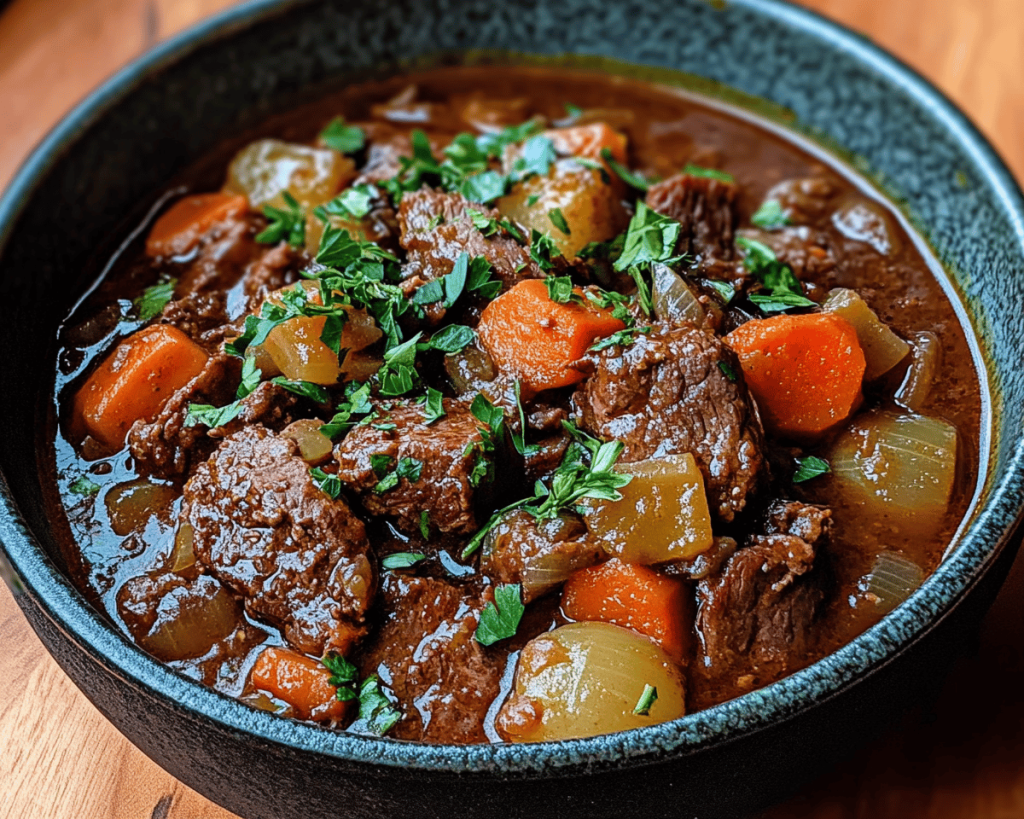There’s something truly magical about the warmth and comfort of a home-cooked meal, especially one that tells a story, isn’t there? For me, this Authentic Belgian Slow-Cooked Beef Stew takes me right back to when I was a kid, sitting in my grandmother’s cozy kitchen, the aroma of bubbling stew filling every corner of her tiny home. I can still hear the soft crackle of the fire in the hearth, and the way she’d smile when I’d eagerly ask, “Is it done yet?” Such a simple question, yet it held the key to countless moments of joy and shared love over dinner tables filled with laughter.
Now, the history of this stew is as rich as its flavor. Originating from Belgium, this dish, known as *carbonnade flamande*, is often made with a hearty dose of Belgian beer, which gives it that fantastic depth of flavor. You know what I mean — it’s like a warm hug on a cold day. I could never quite capture my grandmother’s magic, but each time I try to recreate it, I’m reminded of those sweet little kitchen moments, the clanging of pots, and the joy of cooking together. And honestly, every time I take a spoonful, I can almost hear her chuckle as I mess it up with my clumsy yet enthusiastic cooking style. Nobody’s perfect in the kitchen, and that’s part of the fun!
So grab your apron and prepare to make your own version of this warm, hearty stew. Trust me, it’s a labor of love, and the end result will be well worth it.
What Goes Into Authentic Belgian Slow-Cooked Beef Stew?
Let’s break down what you’ll need for this scrumptious dish. I like to think of the ingredients as the main cast in our little cooking drama, each playing its role in bringing this stew to life. Each has its quirks and a personal touch — just like us!
– **Beef Chuck:** The backbone of our stew! I typically use around three pounds of **beef chuck**, cut into generous chunks. Make sure you don’t skimp here—this is where we get that rich flavor. I aim for well-marbled beef because that fat renders down beautifully during cooking, making everything juicy and tender. Plus, it’s forgiving in terms of cooking time. I remember once using a leaner cut, and let me tell you, it ended up as tough as an old shoe!
– **Onions:** Honestly, who could live without **onions**? Two large ones, finely chopped, will do the trick. They provide a lovely sweetness that balances the flavors. Back in the day, my grandma always said to let the onions sauté till they’re golden; that’s where the magic begins. They add so much warmth to the dish.
– **Carrots:** I always add about three medium **carrots**, sliced into rounds. Their natural sweetness pairs beautifully with the beef and adds that gorgeous pop of color. Plus, they remind me of sunny garden days, digging in the dirt with my cousins, looking for the freshest carrots. Good times!
– **Garlic:** Can you ever have too much **garlic**? I use three cloves, minced, because I like my stews flavorful. A little caveat, though—if you find yourself tearing up while chopping, just remember, it’s all for a good cause. Don’t sweat it!
– **Beer:** A good Belgian beer is essential. I use about a bottle (that’s around 12 ounces) of a malty beer like **Dubbel** or **Flanders Red Ale**. It’s what gives this stew its hearty flavor. Fun fact: the first time I made this, I grabbed a fruity beer instead—what a disaster! It tasted like a confused fruit salad instead of a rich stew.
– **Beef Broth:** Around two cups of **beef broth** will add that savory depth. I swear by homemade stock when I have it on hand; it makes a world of difference. If I’m using store-bought, I’ll always choose low-sodium. It gives me room to adjust the seasoning later without going overboard.
– **Thyme and Bay Leaves:** Fresh or dried, I use a couple of sprigs of **fresh thyme** and a **bay leaf**. They’re like the secret agents of the flavor world—subtle yet undeniably important. I can’t tell you how many times I’ve forgotten to add them, only to realize mid-meal that something feels “off.” Let’s just say I learned my lesson the hard way!
– **Mustard:** One tablespoon of **Dijon mustard** adds a zing that cuts through the richness. For me, this is where the stew springs into life; it transforms the dish in a way that’s both surprising and delightful. Honestly, you might think, “Mustard? In stew?” but you’ll thank me later!
– **Brown Sugar:** And to finish things off, about a tablespoon of **brown sugar** to round out all those flavors nicely. Remember, it’s not about making the dish sweet—it’s about enhancing the natural flavors. Just a little trick I picked up along the way!
– **Salt and Pepper:** I season to taste with **salt and pepper**. This is where you get to show off your palate. And hey, I won’t judge if you taste and adjust along the way—cooking should be about joy, not anxiety!
Is Authentic Belgian Slow-Cooked Beef Stew Actually Good for You?
Now, let’s get real for a second: this stew isn’t exactly a salad but hear me out. I’ve always believed in enjoying the good stuff in life, and this stew is no exception. It’s a bit indulgent, thanks to the **beef** and **beer**, but you’re also getting a heap of **vegetables** and *protein* to balance things out.
Here’s the thing: our beef is loaded with iron, which is great for maintaining energy levels (especially when you’re juggling work, friends, and that new Netflix series you can’t stop binge-watching). The **carrots** bring in a good chunk of beta-carotene, and don’t get me started on the depth of flavor from the herbs! No, it’s not a health-food blog, but it sure is nourishing for the soul.
And honestly, in a world that pushes for perfection and green smoothies, sometimes you just need a stew that warms your heart, fills your belly, and gives you a good excuse to huddle under a blanket on the couch. Life’s too short not to indulge occasionally, right?
Here’s What You’ll Need
– 3 pounds **beef chuck**, cut into chunks
– 2 large **onions**, finely chopped
– 3 medium **carrots**, sliced
– 3 cloves **garlic**, minced
– 12 ounces **Belgian beer** (I recommend Dubbel)
– 2 cups **beef broth** (preferably low-sodium)
– 2 sprigs of **fresh thyme**
– 1 **bay leaf**
– 1 tablespoon **Dijon mustard**
– 1 tablespoon **brown sugar**
– **Salt and pepper** to taste
(honestly, a loaf of crusty bread for dipping wouldn’t hurt either!)
How to Make Authentic Belgian Slow-Cooked Beef Stew Step-by-Step
Alright, let’s get cooking! Buckle up, my friend. This is where we turn ingredients into magic.
1. **Sear the Beef:** Start by heating a large Dutch oven or heavy-bottomed pot over medium-high heat. Add a tablespoon or two of oil (vegetable or olive will do) and begin to sear the **beef** in batches. You want a nice caramelized exterior. Honestly, don’t overcrowd the pan; it just steams the meat instead of searing it. It’s a bit of a dance, but once you get that nice brown crust, remove the beef and set it aside.
2. **Cook the Onions:** In the same pot, toss in the **onions**. Saute them for about 5-7 minutes, or until they’re starting to become translucent and just a tad caramelized. The smell will make you want to dive in right then and there! (I suggest not to, however.)
3. **Add Carrots and Garlic**: Toss in the **carrots** and **garlic**. Stir them around, letting them mingle with the onions for another 3-5 minutes. This is where they start to get soft, and your kitchen will smell divine.
4. **Pour in the Beer:** Now, grab that bottle of **beer** and pour it into the pot—sipping a little for yourself is entirely optional. Use a wooden spoon to scrape up those delicious brown bits at the bottom of the pot. That’s flavor, my friend, and we don’t want to waste any of it.
5. **Return the Beef:** Add the seared beef back into the pot, along with any juices that have accumulated. Stir it all together nicely.
6. **Pour the Broth:** Now, add your **beef broth**. It should cover the meat and vegetables by about an inch or so. If you love a thicker stew, you can let it reduce a bit later.
7. **Season and Simmer:** Toss in the **thyme**, **bay leaf**, **mustard**, **brown sugar**, and season generously with **salt and pepper**. Bring the pot to a gentle simmer. Once it’s bubbling slightly, reduce the heat to low.
8. **Slow Cook:** Cover it loosely with a lid and let it simmer away for about 2 to 3 hours. You’ll want to stir it occasionally and keep an eye on the magic happening inside. The longer it simmers, the better it gets. I often end up making it on a lazy Sunday afternoon, letting the smell hug my house like an old friend.
9. **Check the Consistency:** After a couple of hours, taste it! Adjust the seasonings if necessary. I love letting it simmer for a bit longer sometimes – it just gets richer. If it’s too watery for your taste, you can remove the lid and let it simmer for an extra 30 minutes to reduce it down.
10. **Serve**: When it’s finally ready, serve it hot, ideally with a side of crusty bread to dip. You can also garnish it with some fresh thyme if you’re feeling fancy!
Little Extras I’ve Learned Along the Way
Now that you know how to make the stew, let’s talk about some little tips and tricks I’ve picked up over the years that might save you some time… or just add a little personalization to your dish.
– **A Splash of Vinegar:** If it tastes a little too rich for your liking, a splash of red wine vinegar or regular white vinegar can help brighten the flavors. It’s like a magic trick I learned one day!
– **Add Potatoes:** Some folks love to throw in a couple of cubed potatoes. They soak up the flavors beautifully and make the stew more filling. I usually reserve that for gatherings when I have more mouths to feed.
– **Crockpot Option:** If you’re like me and part of your heart belongs to your crockpot, you can easily adapt this recipe! Just sear the beef first, throw everything into the slow cooker, and let it do the work for 6-8 hours on low. If I’m having a busy week, this is my go-to.
– **The Beer Dilemma:** If you don’t drink alcohol or just want to skip the beer, you can use a good quality beef broth or even a splash of apple cider for a different flavor profile. Just remember, those options might alter the essence, but it can still taste fantastic.
So there you have it! A labor of love, bottled in a cozy pot of wonder. This Authentic Belgian Slow-Cooked Beef Stew is meant for sharing, for stirring up memories, and for creating new ones. It’s a recipe that warms the heart and nourishes the soul, and it’s definitely worth trying.
This one means a lot to me. Let me know if you try it—I’d love to hear your twist.



